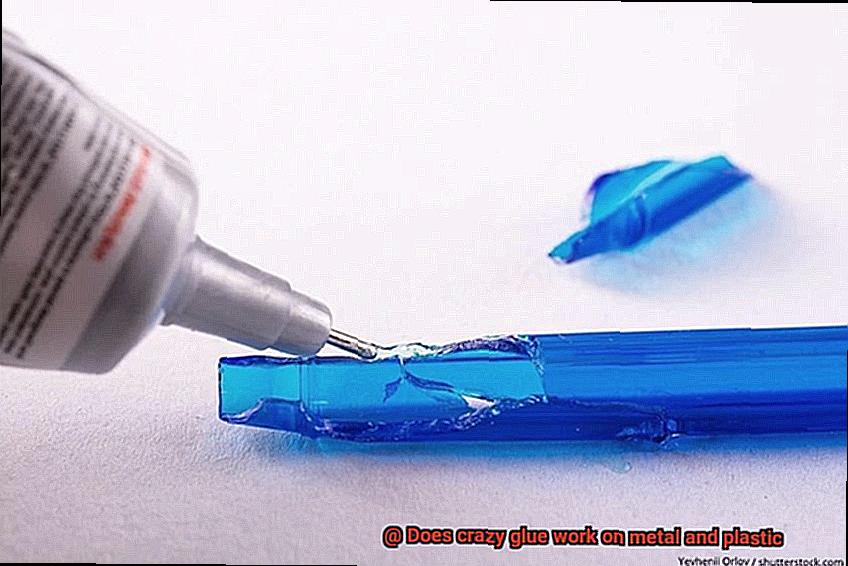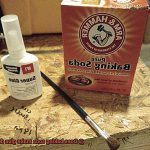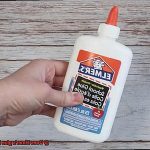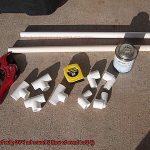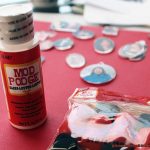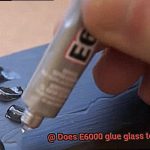Looking for the perfect adhesive to fix your metal or plastic items? Look no further. Today, we’re diving into the world of crazy glue and its magic on these surfaces. Crazy glue, also known as super glue or cyanoacrylate adhesive, is quick-drying and has a strong bond. But does it live up to the hype? Can crazy glue truly work its magic on metal and plastic?
Imagine this: you’re in the middle of a DIY project when suddenly your favorite figurine shatters into pieces. Panic sets in, but fear not. Crazy glue might just be your saving grace. Whether it’s a metal charm or a plastic toy, this adhesive is a household staple for its versatility.
But before we go any further, let’s talk about the science behind the madness. Crazy glue creates a chemical reaction when it touches moisture, bonding surfaces together in seconds. Its incredible adhesive properties make it perfect for various materials like ceramics, wood, and yes – metal and plastic too.
While every situation is different, crazy glue has proven to be remarkably effective on a wide range of metal and plastic surfaces. Whether you’re fixing a broken keychain, reattaching a handle to your favorite mug, or even mending a plastic chair – crazy glue can be your instant fixer-upper.
However, not all crazy glues are created equal. Some work better on specific materials, so choose wisely. And remember, proper surface preparation and application techniques can make all the difference.
So whether you’re an artsy craftsy person or just need a quick repair job done right – crazy glue could be your secret weapon. In this blog post, we’ll explore the compatibility of crazy glue with metal and plastic surfaces. We’ll uncover tips, tricks, and potential limitations to ensure your projects stick together seamlessly. Get ready as we unravel the mysteries and unveil the truth about this remarkable adhesive.
What is Crazy Glue?
Contents
- 1 What is Crazy Glue?
- 2 Does Crazy Glue Work on Metal?
- 3 Does Crazy Glue Work on Plastic?
- 4 Advantages of Using Crazy Glue for Metal and Plastic
- 4.1 Advantage 1: Lightning-Fast Drying Time
- 4.2 Advantage 2: Unyielding Strength and Durability
- 4.3 Advantage 3: Versatility at Its Finest
- 4.4 Advantage 4: Crystal-Clear Transparency
- 4.5 Advantage 5: Portability for On-the-Go Repairs
- 4.6 Advantage 6: Effortless Application
- 4.7 Advantage 7: Long Shelf Life
- 4.8 Advantage 8: Cost-Effective Solution
- 5 Disadvantages of Using Crazy Glue for Metal and Plastic
- 6 Tips for Using Crazy Glue on Metal and Plastic Surfaces
- 7 Alternatives to Crazy Glue for Bonding Metal and Plastic
Crazy Glue, scientifically known as cyanoacrylate adhesive, is a marvel in the world of adhesives. This versatile adhesive has earned its reputation as a go-to solution for bonding materials together. From metal to plastic, Crazy Glue works its magic, creating strong and durable bonds in mere seconds. Let’s embark on a journey into the realm of Crazy Glue and uncover its secrets.
The Power of Crazy Glue:
Crazy Glue is a single-component adhesive, making it incredibly convenient to use. With its liquid form and precision applicator tip, you can wield this adhesive with ease, ensuring precise application exactly where it’s needed. Once dry, Crazy Glue becomes transparent, seamlessly blending into your bonded materials for a visually pleasing finish.
Unleashing Its Potential:
When it comes to bonding metal surfaces, Crazy Glue shines bright. Its phenomenal strength enables it to bond various metals like aluminum, steel, brass, and copper with unwavering tenacity. However, achieving optimal results depends on factors such as surface condition and cleanliness. Smooth and pristine metal surfaces provide the ideal canvas for Crazy Glue’s prowess.
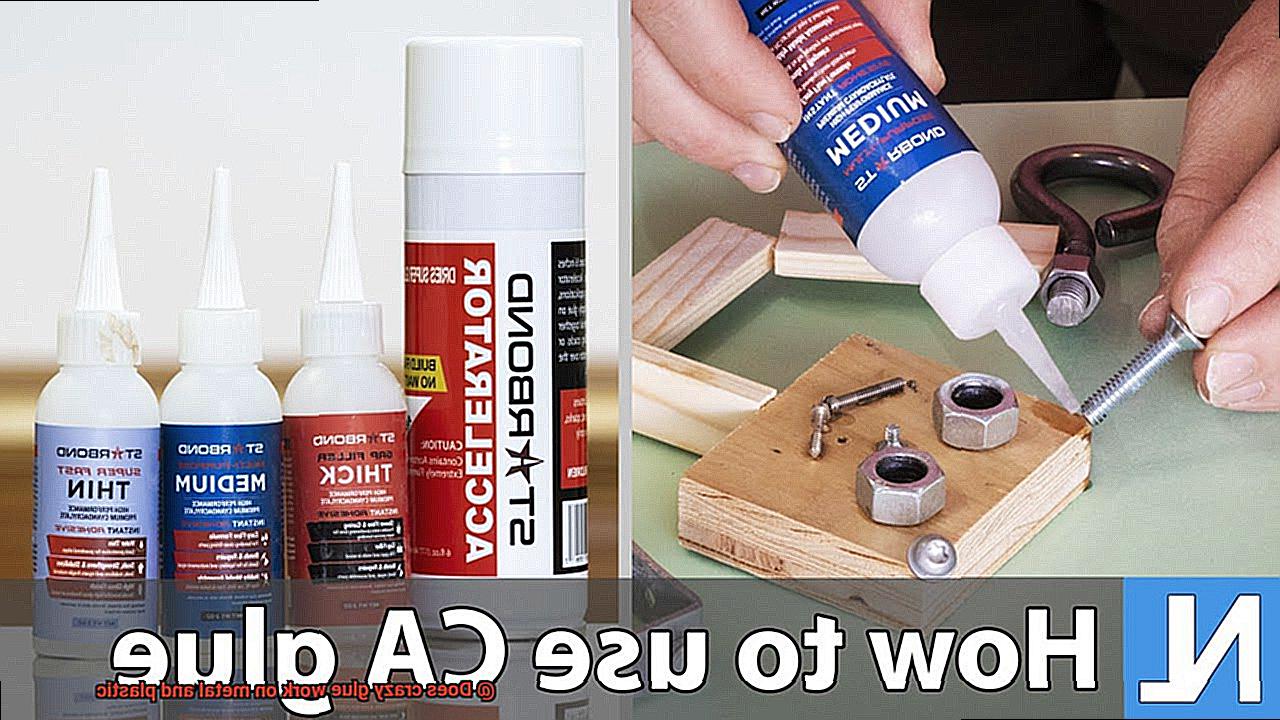
But wait, there’s more. Crazy Glue also possesses an affinity for plastic materials. It can effectively bond common plastics such as ABS, acrylic, polycarbonate, and PVC. Nevertheless, not all plastics are created equal; some may require additional treatment or priming to ensure an unbreakable bond.
Tips for Success:
To harness the full potential of Crazy Glue, follow these invaluable tips:
- Prepare the surface: Thoroughly clean and remove any contaminants from the bonding surfaces for optimal results.
- Fit matters: Ensure precise alignment and fit between the parts to be bonded.
- Apply the right amount: A thin layer of Crazy Glue is all it takes to create a bond of unparalleled strength. Avoid excessive application that may compromise the integrity of the bond.
- Allow proper curing time: Patience is key. Give the adhesive sufficient time to cure fully before subjecting it to stress or movement.

Limits and Alternatives:
While Crazy Glue is an exceptional adhesive, it does have its limitations. Extreme temperatures and exposure to certain chemicals can weaken its bond. In such cases, specialized adhesives like epoxy or polyurethane may be more suitable for achieving optimal results.
Does Crazy Glue Work on Metal?
Well, buckle up because I’ve done some research to uncover the truth. So grab your goggles and let’s explore the fascinating world of metal bonding with Crazy Glue.
Not all metals are created equal when it comes to Crazy Glue’s power. Smooth and non-porous metals like stainless steel, aluminum, and copper are a match made in adhesive heaven. So if your project involves these metals, you’re off to a great start.
But before you unleash Crazy Glue on that metal surface, make sure it’s squeaky-clean. Dirt or oil will hinder the glue from working its magic. So grab a degreaser or some rubbing alcohol and give that metal a good scrub.
Now comes the fun part. Apply a small amount of Crazy Glue directly onto the metal surface and hold the pieces firmly together for a few seconds. Follow the manufacturer’s instructions carefully for optimal results. Witness the birth of an unbreakable bond.
But here’s the catch – not all metals are worthy of Crazy Glue’s power. Some metals with rough surfaces or high porosity might not provide enough area for the glue to adhere properly. In such cases, turn to specialized adhesives designed specifically for bonding metals.
Oh, and one more thing: Crazy Glue might struggle under extreme heat or exposure to harsh chemicals. If your project involves these conditions, explore alternative adhesives like epoxy or polyurethane.
Before you embark on your metal-bonding adventure, test Crazy Glue on a small and inconspicuous area of the surface. Ensure the adhesive is up to the task and avoid any potential mishaps.
Does Crazy Glue Work on Plastic?
Whether you’re a crafting wizard or a fix-it aficionado, understanding the effectiveness of Crazy Glue on various types of plastic surfaces is essential. So, let’s dive in and uncover the secrets behind this adhesive wonder.
Different Types of Plastic:
Not all plastics are created equal. Crazy Glue, also known as cyanoacrylate adhesive, works exceptionally well on rigid plastics such as acrylic, polycarbonate, and ABS (Acrylonitrile Butadiene Styrene). These materials provide a solid foundation for the adhesive to create a strong bond.
Factors to Consider:
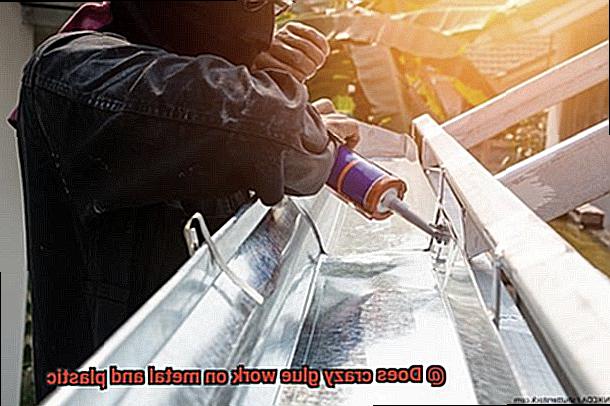
However, when dealing with flexible or low surface energy plastics like polyethylene or polypropylene, Crazy Glue may not be as effective. These types of plastics have unique properties that make bonding a bit more challenging. But fear not – there are solutions.
Preparation is Key:
To ensure optimal results, it is crucial to prepare the plastic surface before applying Crazy Glue. Clean the surface thoroughly to remove any dirt, grease, or moisture. Wipe the area with rubbing alcohol or acetone to create a clean and dry surface, setting the stage for a successful bond.
Application Techniques:
Applying a small amount of Crazy Glue to both surfaces that need to be bonded and pressing them together firmly for a few seconds allows the adhesive to set properly. This technique ensures maximum contact between the glue and plastic, resulting in a stronger bond.
Enhancing Adhesion:
If you’re working with heavily textured or rough plastic surfaces, don’t fret. There are ways to improve adhesion. Consider roughening the surface with sandpaper to create a better bonding surface. Alternatively, using a primer specifically designed for bonding plastic can also enhance the effectiveness of Crazy Glue.
Strength and Durability:
Once the Crazy Glue has fully cured, it forms a robust bond that can withstand moderate stress and temperature changes. However, keep in mind that excessive force applied to the bonded plastic surfaces may cause them to break rather than the adhesive failing. It’s always essential to assess the load-bearing requirements of your project before selecting Crazy Glue as your adhesive of choice.
In conclusion, Crazy Glue can be an excellent option for bonding plastic surfaces, particularly rigid plastics like acrylic, polycarbonate, and ABS. With proper surface preparation and application techniques, you can achieve a strong and durable bond. However, it’s crucial to consider the type of plastic you are working with and its specific characteristics.
When dealing with flexible or low surface energy plastics, exploring alternative adhesives or specialized bonding solutions may be necessary. Always read and follow the manufacturer’s instructions for best results when using Crazy Glue on plastic.
Advantages of Using Crazy Glue for Metal and Plastic
Adhesives have revolutionized repairs, creations, and innovations. Among the vast array of options available, Crazy Glue, also known as cyanoacrylate adhesive, stands out as a formidable force when it comes to bonding metal and plastic surfaces.
In this blog post, we will explore the numerous advantages of using Crazy Glue for these materials, unlocking its potential to transform your DIY projects into works of art.
Advantage 1: Lightning-Fast Drying Time
Crazy Glue boasts a quick-drying feature that bonds within seconds, unlike other adhesives that require hours to cure. This time-saving advantage allows you to complete repairs or projects efficiently without sacrificing quality.
Advantage 2: Unyielding Strength and Durability
Crazy Glue forms an incredibly strong bond between metal and plastic surfaces. Its tight seal is resistant to moisture, heat, and most chemicals, ensuring a long-lasting and reliable bond. Whether you’re fixing a broken metal object or joining diverse plastic components together, Crazy Glue guarantees unwavering strength and durability.
Advantage 3: Versatility at Its Finest
From aluminum to brass, steel to copper, Crazy Glue adheres effortlessly to a wide range of metals. Its compatibility extends to various plastic types like PVC, ABS, acrylic, and polycarbonate. With this adhesive wonder on your side, you’ll never have to worry about material limitations again.
Advantage 4: Crystal-Clear Transparency
Maintaining aesthetics is crucial when working with metal and plastic surfaces. Thankfully, Crazy Glue excels in creating transparent bonds that seamlessly blend into the surroundings. Say goodbye to unsightly marks and hello to flawlessly repaired or joined parts.
Advantage 5: Portability for On-the-Go Repairs
Crafted with convenience in mind, Crazy Glue comes in small containers that are easy to carry around. Its portability empowers you to tackle on-the-spot repairs or projects without the need for extensive tools or equipment. You’ll be a DIY superhero, ready to save the day wherever you go.
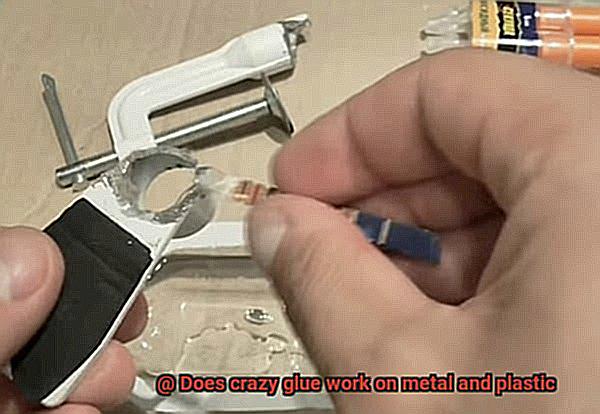
Advantage 6: Effortless Application
Bid farewell to cumbersome clamping or holding pressure required by traditional glues. With Crazy Glue, external pressure is unnecessary, simplifying the application process and minimizing the risk of accidental movement or misalignment of bonded parts.
Advantage 7: Long Shelf Life
Crazy Glue boasts an impressive shelf life when stored correctly. It can last for years without losing its effectiveness. This means that even if you only require a small amount for a specific project, you can keep the remaining glue for future use, ensuring maximum value for your investment.
Advantage 8: Cost-Effective Solution
In today’s world, cost matters. Luckily, Crazy Glue offers an affordable alternative to more specialized adhesives. With its exceptional bonding capabilities and accessibility in hardware and craft stores, you can save money without compromising on quality.
Disadvantages of Using Crazy Glue for Metal and Plastic
When it comes to bonding metal and plastic, Crazy Glue may initially seem like a convenient choice. However, it’s important to be aware of the potential disadvantages that come along with using this popular cyanoacrylate adhesive for these materials. Understanding these drawbacks will help you make an informed decision and choose the right adhesive for your specific project.
- Limited Bonding on Rough Surfaces: One major disadvantage of using Crazy Glue for metal and plastic is its limited ability to bond on rough or textured surfaces. While it works best on smooth and non-porous surfaces, it struggles to adhere to irregular or uneven surfaces. This can be a significant drawback when trying to bond metals or plastics that have rough or textured exteriors. The lack of a strong bond can lead to the failure of your project, leaving you frustrated and disappointed.
- Weakness in High Temperatures: Another disadvantage of Crazy Glue is its vulnerability to high temperatures. When exposed to heat, the adhesive can weaken or even break down completely, causing the bond between the metal and plastic to fail. This limitation restricts its usability in applications where the bonded materials might be subjected to heat or extreme temperatures. If you’re working on a project that involves heat exposure, it’s crucial to consider alternative adhesives that offer better temperature resistance.
- Brittle Bond: Once Crazy Glue dries, it becomes quite brittle. While this may not be an issue for some applications, it can be problematic when bonding materials that are subjected to frequent movement or stress. The lack of flexibility in the adhesive can lead to cracks or breaks in the bond over time. If you’re working on a project that requires durability and long-term stability, Crazy Glue may not be the best choice.
- Ineffective on Certain Plastics: Certain types of plastics, such as polyethylene or polypropylene, have low surface energy, making it difficult for Crazy Glue to form a strong bond. These plastics are commonly used in various applications, and if you’re working with them, specialized adhesives are required for effective bonding. Neglecting this limitation and attempting to use Crazy Glue on these plastics may result in a weak bond that fails to meet your expectations.
- Precise Application Required: Crazy Glue is notorious for its quick-drying nature. In some cases, it can dry within seconds, leaving little room for error during application. This means that you need to be extremely precise and careful when applying the glue. Any inaccuracies or excess glue can create a messy appearance and potentially weaken the bond between the metal and plastic. If you’re not confident in your ability to apply the adhesive accurately, it may be worth considering other options that allow for more forgiving application processes.
- Lack of Reversibility: Once Crazy Glue has bonded two surfaces together, it becomes challenging to separate them without causing damage. This lack of reversibility can be problematic if adjustments need to be made or if the bond needs to be undone in the future. Other adhesives, such as epoxy or certain types of super glues, offer more flexibility in terms of reversibility, allowing for easier adjustments or bond removal when needed.
- Skin and Eye Irritation: Lastly, it’s important to note that Crazy Glue can be irritating to the skin and eyes. The adhesive contains chemicals that can cause discomfort and potential harm if they come into contact with sensitive areas. It’s crucial to handle the adhesive with care and avoid any accidental contact with your skin or eyes. If contact does occur, it is recommended to rinse the affected area thoroughly with water and seek medical advice if necessary.
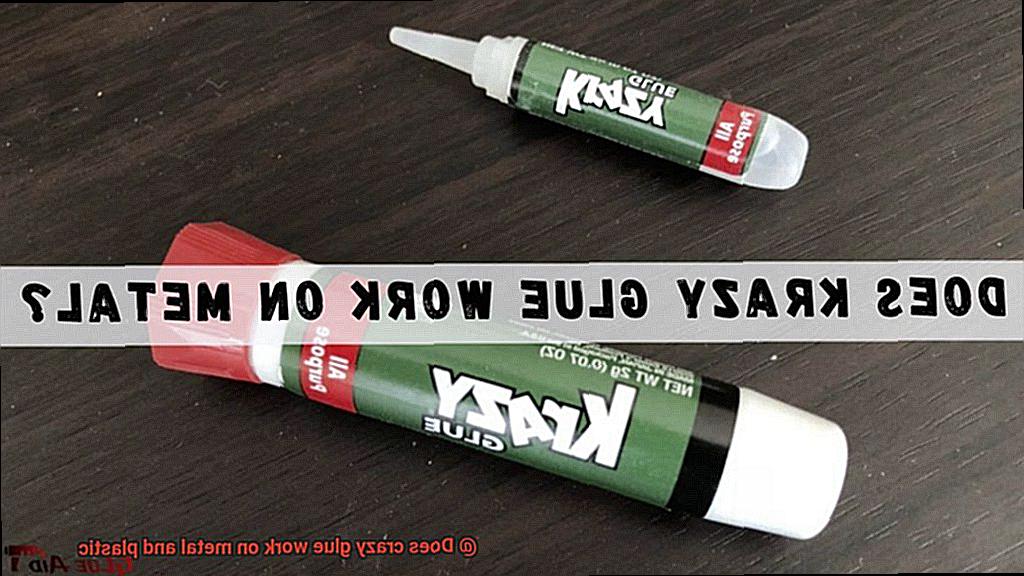
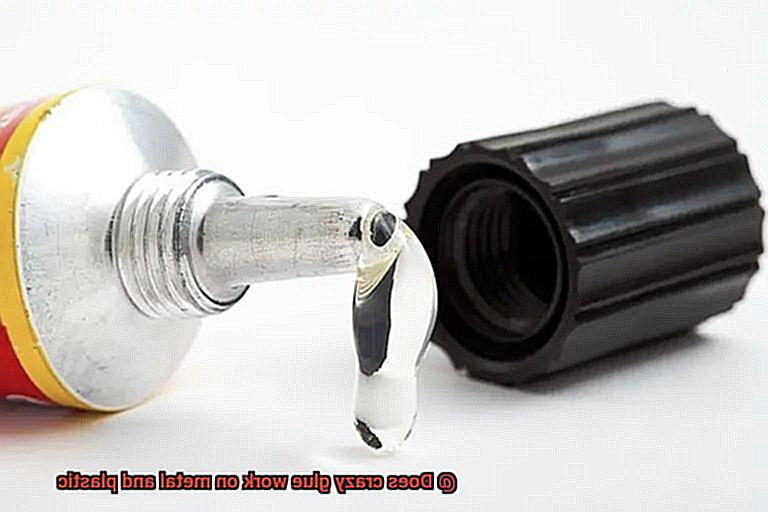
Tips for Using Crazy Glue on Metal and Plastic Surfaces
In this article, we’ll dive into some expert tips and techniques to ensure a successful bond between these two materials. So grab your gloves and let’s get started.
Cleanliness is Key:
Before applying Crazy Glue, it’s crucial to clean the metal and plastic surfaces thoroughly. Use a mild detergent or degreaser to remove any dirt, grease, or oil. Rinse with water and allow the surfaces to dry completely before moving on to the next step. A clean canvas ensures a strong and long-lasting bond.
Roughen Up the Surface:
To enhance the bonding process, consider roughening the surface slightly. This can be done by using fine-grit sandpaper or a scoring tool to create small scratches on the metal or plastic. These tiny grooves provide more surface area for the glue to grip onto, resulting in a stronger bond.
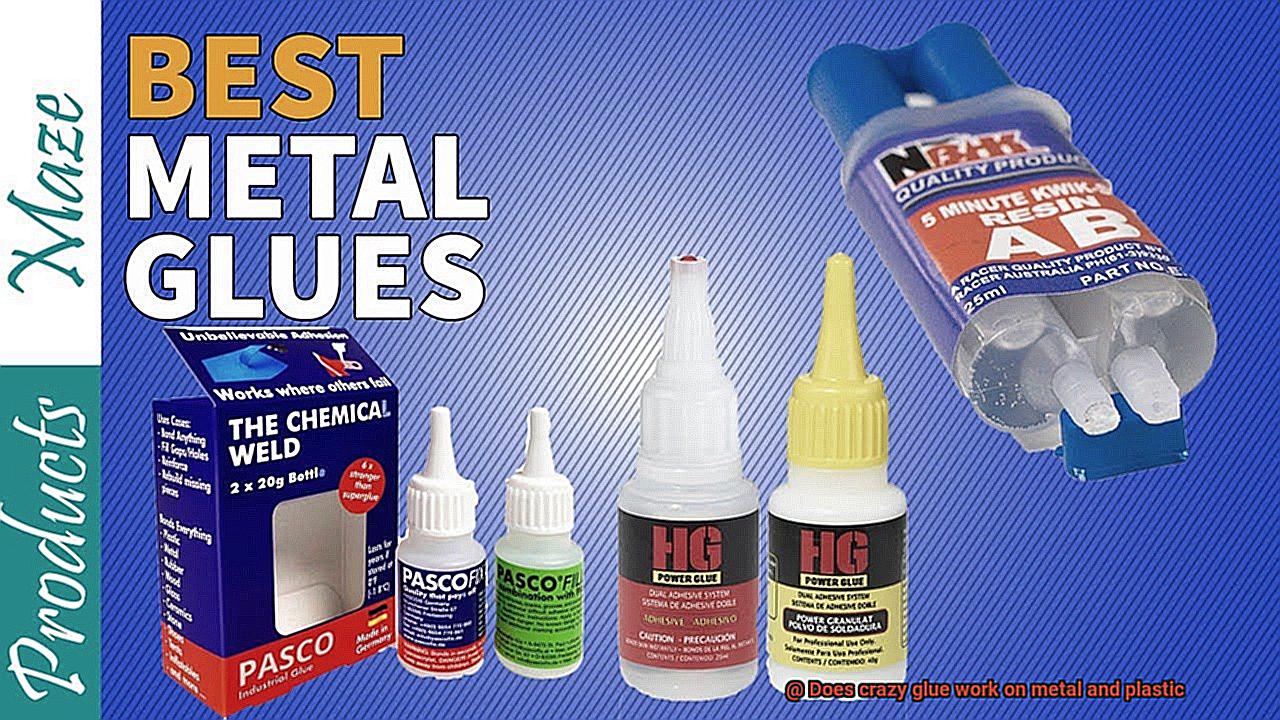
Test Before You Bond:
Every material is unique, and different types of metal and plastic may react differently to Crazy Glue. It’s always wise to test the adhesive on a small, inconspicuous area before committing to a full bond. This will help you ensure compatibility and determine if the glue provides the desired strength.
Apply with Precision:
When using Crazy Glue on metal surfaces, apply a thin, even layer of glue across the surface. Avoid using excessive amounts, as it can lead to messy application and longer curing times. Press the two surfaces firmly together and hold them in place for a few minutes to allow the glue to bond.
Punctures for Plastics:
Plastic surfaces require special attention. Due to their non-porous nature, it can be helpful to create small punctures or perforations before applying the glue. Use a needle or pin to make tiny holes that allow the glue to seep in and form a stronger bond.
Alternatives to Crazy Glue for Bonding Metal and Plastic
In the vast world of adhesives, there are numerous alternatives to Crazy Glue for bonding metal and plastic. Whether you’re a DIY enthusiast or a professional craftsman, finding the perfect adhesive can make all the difference in your project. So, let’s delve into the realm of these alternatives and explore their unique characteristics.
First on our list is the mighty epoxy adhesive. Renowned for its strength and durability, epoxy adhesive is a top choice for bonding metal and plastic. Comprising two components – a resin and a hardener – this adhesive requires careful mixing before application. Once mixed, it transforms into a formidable bonding agent that can be skillfully applied to the surfaces you wish to unite. Remember to follow the manufacturer’s instructions for optimal results.
Next up is the versatile polyurethane adhesive. This flexible glue proves ideal for bonding various materials, including metal and plastic. Packaged in convenient tubes or cartridges, it can be effortlessly applied using a caulking gun or similar tool. However, exercise patience as this adhesive requires some curing time to reach its full strength. Allow it to set before subjecting the bond to any stress.
Now, let’s explore the beloved super glue. Cyanoacrylate adhesive, commonly known as super glue, offers another alternative for bonding metal and plastic. While Crazy Glue falls into this category, it is not the only player in town. Other brands and variations of cyanoacrylate adhesive are available too. These adhesives work their magic by reacting with ambient moisture, creating a robust bond. Sold in petite tubes or bottles, they can be directly applied to the surfaces in need of bonding. However, bear in mind that super glue tends to be brittle, making it unsuitable for applications requiring flexibility.
Last but certainly not least are specialty adhesives tailored specifically for bonding metal and plastic. These magical concoctions are formulated with properties that make them ideal for such applications. Some offer exceptional resistance to high temperatures, rendering them perfect for automotive or industrial projects. When choosing a specialty adhesive, peruse the product labels diligently and select one recommended for your specific materials and conditions.
While selecting the right adhesive is crucial, proper surface preparation plays a pivotal role too. Ensure that the surfaces are spotless, free from dirt, oil, or contaminants that could hinder bonding. Certain adhesives may necessitate roughening or etching of the surfaces for enhanced adhesion. Do not underestimate the significance of this key step in achieving a solid bond.
_uYUoZvkPr4″ >
Also Read: Does Krazy Glue Work on Metal?

